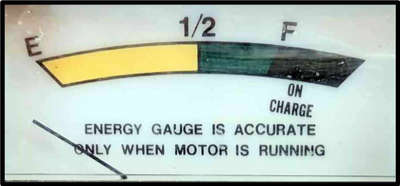Batteries & Related Systems
Battery Monitoring
Duffy Energy Gauge
There is an "Energy Gauge" on the instrument panel that looks like a fuel gauge, with
Empty and Full markings at each end.
It is actually a Volt meter, which
is inadequate to determine the remaining capacity of the batteries.

Here are some things it can provide an indication of:
-
Rough Battery Bank Voltage
When disconnected from shore power, the key switch is on, and all systems are off, the meter will show available battery bank voltage when not under load. Since there are no voltage markings on the gauge, you will need a reference point on the meter to determine if your batteries are at a normal charge level. -
Voltage while under load and a rough idea of available battery power
For a given load (e.g. full speed throttle), voltage will be lower on a battery bank that has less available power. With a new set of batteries, you will see the voltage drop when at full throttle and then slowly decline as you continue motoring. With batteries that are near end-of-life, you will see a greater drop in voltage initially and a more rapid decline as you continue motoring. This will correspond with reduced speed and range as your batteries are unable to provide the required power. -
Whether your battery charger is working or not
Charging the batteries requires the battery charger to produce a higher voltage than the maximum combined voltage of your battery bank (e.g. 40V for a 36V system). This is why Duffy advises to remove shore power before turning on boat power with the key.
To be safe, turn off all lights and other systems. When you turn on the key, the volt meter will show a higher voltage while charging than when not.
Battery Chemistry and Motor Controller Effects on Monitoring
Lead acid batteries exhibit a significant voltage drop under load, which is exaggerated in older batteries with less remaining energy. The motor controller will do its best to provide an optimal power profile to the motor regardless of battery state. As a result, everything will seem fine when motoring until the motor controller can no longer compensate.
Accurate Battery Monitoring
State of Charge (SoC) quantifies the remaining capacity available in a battery at a given
time and in relation to a its decline in ability to produce energy over time. It is usually
expressed as a percentage.
To display SoC, the boat would need a monitoring system
that would
1) know the present amp hour capacity of your battery bank and
2) be
able to constantly monitor power consumption in order to display remaining capacity
Third party marine SoC battery monitors are available (search for "marine battery monitor with shunt" or "Coulometer"). These require some rewiring and periodic calibration to reflect the remaining maximum capacity of your batteries.
If you switch to LiFePO4 batteries, they will have a built-in or separate battery management system that will be able to provide an accurate SoC.
